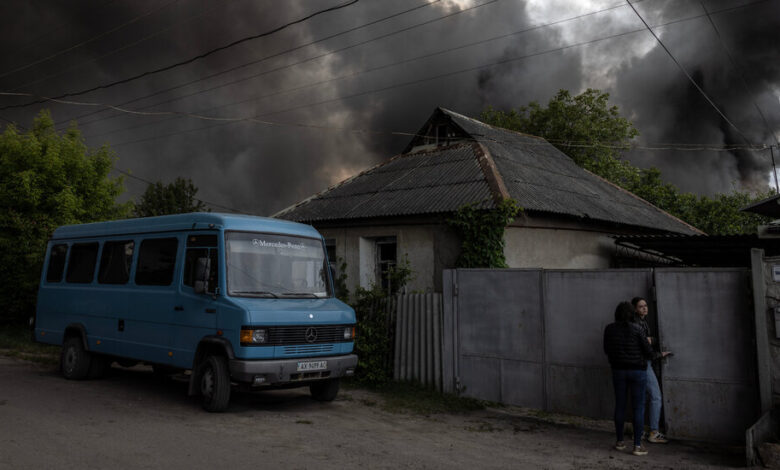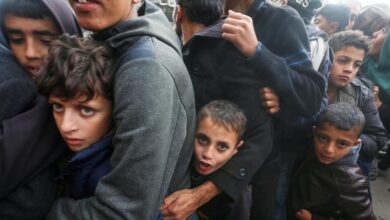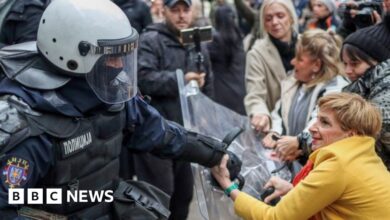Russia attacks in Northeast Ukraine, looking for a buffer zone on the border

Russian forces on Saturday continued to push deeper into northeastern Ukraine, moving closer to a village about 16 kilometers outside Kharkiv and raising fears that Ukraine’s second-largest city could soon be in range of Russian artillery.
Ukrainian Army said on Saturday that Russian troops attempted to breach the defenses near the village of Lyptsi, located just north of Kharkiv. It said the attacks were repelled, but map Later battlefield Compiled by independent groups, analysis of publicly available video of the fighting shows that Russian troops have almost reached the outskirts of the village.
Ukraine’s Khartia Brigade is defending Lyptsi, posted a video on Telegram on Friday afternoon said there were scenes of Russian soldiers walking into the village and attacking in small groups among the trees. The brigade said it targeted the Russians with missiles, forcing them to retreat.
Russian army opening a new front in northeastern Ukraine a week ago, swept across the border and quickly captured about 10 settlements in what Ukrainian officials and military analysts described as an effort to stretch Ukraine’s already outnumbered forces.
For example, the Khartia Brigade was redeployed from another hot spot on the front, around Ocheretyne, a village in the southeast. Russian forces captured Ocheretyne last month, creating holes in Ukraine’s defense system.
But experts say another, perhaps more immediate, Russian goal could be to advance deep enough into Ukrainian territory to push Kyiv’s forces away from the border, creating a buffer zone to prevent Ukrainian troops from attacking. attack Russian towns and cities with artillery. President Vladimir V. Putin of Russia said on Friday that that was the target of the current attack.
The buffer zone could also allow Russian forces to get close enough to Kharkov to attack with artillery shells, escalating tensions. Moscow’s campaign aims to make things difficult for the city’s residents by hitting residential areas with airstrikes and targeting its power plants to cut power.
“Such a buffer zone of 10 to 15 kilometers will definitely create problems for Kharkiv,” said Mykola Bielieskov, a military analyst at the government-run Institute for National Strategic Studies in Ukraine.
Further Russian advances would return Kharkiv, now home to about 1.2 million people, to the situation it faced in the early months of the war. In 2022, Russian troops advanced on the city’s outskirts, forcing hundreds of thousands of people to flee.
Kharkiv Mayor Ihor Terekhov has described Russia’s advance on the city as aimed at sowing chaos and panic. But you repeat last week that there are no plans to evacuate the population. Instead, the city became a temporary home for thousands of Ukrainian civilians fleeing fighting in the region, from villages like Lyptsi or Vovchansk, further east.
However, Kharkiv is not completely safe. In recent months, Russia has increasingly targeted the city with powerful guided missiles known as glide bombs, which can carry hundreds of tons of explosives, and the S-300 anti-aircraft missiles that Moscow currently has. Used to attack targets on the ground.
“It took only a few minutes for the S-300 missile to reach Kharkiv,” Ilya Yevlash, a spokesman for the Ukrainian Air Force, said in an interview this month. “There is no time to respond to these threats.”
Mr. Yevlash said that only the US-made Patriot air defense system can intercept S-300 missiles fired at short range and Ukraine does not have enough of this system. “We can count them on the fingers of one hand,” he said.
Ukrainian officials have called on Western partners to send more troops. “We really need air defense forces to protect Kharkov” and other cities in northeast Ukraine. “It is the time now.”
Putin said Friday that Russian forces have no plans to take over the city. Military experts also believe that Russia lacks the forces to conduct such a campaign.
However, getting closer to Kharkiv is not an easy task.
Russian forces have so far overtaken densely populated and poorly fortified areas. Entering Lyptsi, which had a pre-war population of 4,000 and is dotted with homes and buildings, would force the Russian army into more difficult street fighting.
Emil Kastehelmi, an analyst with the Finnish Black Bird Group, specializes in evaluating satellite images and battlefield footage. recorded on social platform X that “a long chain of villages” separates Lyptsi from Kharkiv. Advancing position by position, he said, “will force the Russians to fight through more than 17 kilometers of built-up area.”
in one Interview with Agence France-Presse news agency on Saturday, Mr. Zelensky said he expected Russia to step up its offensive in the northeast, possibly by opening new fronts elsewhere, such as in the Sumy region, north of Kharkiv.
That will continue to strain Ukraine’s military, which already has to defend a front line more than 600 miles long. In an effort to address the military shortage, the Ukrainian government has adopted a series of measures to expand the pool of people who can enlist.
ONE mobilization law passed last month, which includes incentives for volunteers and new penalties for those who try to avoid military service, took effect on Saturday. Ukrainian men now have two months to update their personal information at military recruitment centers or online, to help authorities more easily identify potential conscripts.
Matina Stevis-Gridneff Contributing reports from Brussels.




